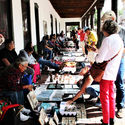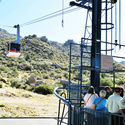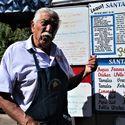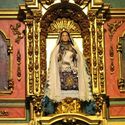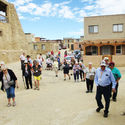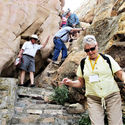New Mexico: 47 Hi-Line Travelers visit the "Land of Enchantment"
November 13, 2019
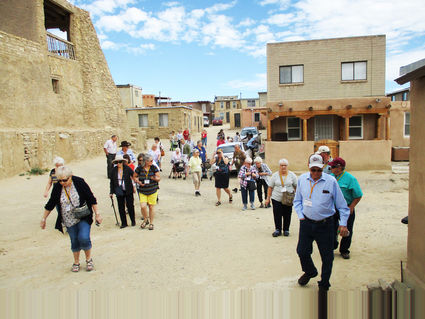
Hi-Line Travelers make their way toward the San Esteban Del Rey Mission at Acoma Pueblo outside Albuquerque. Believed to be one of the longest populated pueblos in the U.S., the Acoma people lived atop a 370 foot mesa that provided a natural defense against intruders. About 300 dwellings are still on the mesa but only 13 families live there year round.
Columnist's note: Forty-seven Hi-Line Travelers recently visited the Land of Enchantment with extended time in Santa Fe and Albuquerque, New Mexico. This was the third coach trip for the group made up of travelers from Glasgow to Chester and south to Polson and Chouteau. We even picked up a couple of new folks from Wyoming and Washington state.
New Mexico was the 47th state, joining the U.S. in January, 1912. Interestingly, much of the state was already settled when the east coast of the U.S. was still uninhabited by any Europeans. Santa Fe, the oldest state capitol in the country, was founded in 1609-that's ten years before the Mayflower landed at Plymouth Rock.
New Mexico's nickname, "Land of Enchantment," describes its varied and scenic beauty and its cultural diversity that draws from both indigenous people and a long influence from Spain. Because of the diversity of its people the state's first constitution had a provision that all laws had to be published in Spanish and English. That provision lapsed many years ago but according to 2010 census data 28% of the state's population aged five and older speaks Spanish at home and 3.5% speak Navajo. That diversity is also seen in the state's architecture and art with, as one would put it, "Fifty shades of beige" referring to the adobe used on both old and modern buildings.
One last note about our travelers: we saw more multi-generational travelers (adult children traveling with parents) than during any of our earlier trips. That's in line with a trend among travelers noted by travel professionals. Also, we enjoyed a number or repeat travelers with 36 of this year's guests having made one or both of the prior trips.

It's really hard to describe all the adventures of a nine day trip. Here's a few of the things we saw and learned in the Southwest.
We left Montana in the season's first snow storm!
We left on Saturday, September 28, the day of the area's first snow for this year. We picked up passengers at Chinook and Harlem, then headed south from the Fort Belknap Agency. There was snow much of the way until we crossed the Missouri River. Our bus driver, though from Coral Springs, Florida had driven motor coaches for many years and the snow was not a problem.
We made a lunch stop and picked up three additional passengers who joined us from Billings and Helena. That night in Buffalo, Wyoming, where we stayed, we had an unscheduled but excellent dinner at the Bozeman Trail Steakhouse, one of those great eating places not on our tour schedule but a nice surprise.
Sunday we left for an overnight stay in the Denver area. In Wheatland, Wyoming we picked up an adult daughter accompanying her mother and two sisters on the tour. That night we stayed in the Denver Technical Center, an area south of the city with specialty shops and small businesses, restaurants and hotels.
The next day we visited the United States Olympic and Paralympic Training Center (OPTC) in Colorado Springs. The OPTC is the flagship training center for U.S. summer Olympic and Paralympic athletes. Olympic hopefuls train there for Boxing, Cycling (Olympic and Paralympic), Figure skating, Gymnastics, Paralympic Judo, Pentathlon, Shooting (Olympic and Paralympic), Paralympic Swimming and Wrestling. Some practice facilities, like figure skating, are at other locales in Colorado Springs.
The Training Center provides housing, dining, training facilities, recreational facilities and other services for more than 500 athletes and coaches at the complex. Athletes are selected by their respective National Governing Body to train at the Colorado Springs OPTC.
One of our tour guides was Sophia Herzog. She joined the national U.S. Paralympics Swim Team in 2015. Herzog learned to swim through the Dwarf Athletic Association of America. Sophie has lived and trained at the center for six years. Her typical week is 20 hours of swimming practice and six hours in the gym. She is a tour guide at the OPTC to help offset some of her training costs. She added athletes stay and train at the center "as long as they are winning medals." She's preparing for the 2020 summer Olympics in Japan.
About 100-125 athletes live at any given time in apartments with their own bedroom and bath and a common living area. Meals are served at separate dining areas. About 500 OPTC professionals provide medical and psychological care and use very sophisticated research and technology to analyze athletic performance. The director of OPTC said, "We have to keep pace with other countries and what they are doing or our athletes will be at a disadvantage."
We arrive at
Bernalillo, New Mexico
Bernalillo is a suburb between Santa Fe and Albuquerque. At the hotel we were met by the general manager, Larry Morinia. Local Montana sports enthusiasts may recall Morinia from his basketball days at MSU-Northern in the early 2000's. The Santa Fe area native said he was at first unsure about winters in northern Montana but learned to adapt and that was the skill that helped him as he played basketball around the world after college.
Our first outing in the metro area was a visit to the Acoma Pueblo, about eighty miles southwest of Bernalillo. The pueblo (Pueblo Indians had their land granted to them in an 1848 treaty between the U.S. and Mexico) is one of the oldest continuously populated indigenous villages in the U.S., dating to about 1100 A.D. Acoma Pueblo sits atop a mesa rising 370 feet above the desert floor. At the village the elevation is 6450 feet.
A roadway was blasted into the side of the mesa to provide access for a movie crew in the 1950's. Prior to that, access was only by the "ancient stairway," a winding route consisting of hand carved steps and finger holds. The limited access provided the people with a natural security system allowing them to see enemies approaching the mesa and providing opportunities to repel intruders
There is no electricity or other utilities atop the mesa. About 300 dwellings on the mesa are owned by tribal women. Fewer than a dozen families, that make up the tribal spiritual leadership, live on the mesa year round. New dwellings are built atop existing structures as no additional ground space can be used for new abodes. Properties are habitable but most tribal members live on the desert floor in nearby villages.
Atop the mesa there are two cisterns that catch rain water. In the old days, when no water was available from rain, women carried water up the ancient stairway from sources on the desert floor. Farming and ranching operations were carried out below the mesa and the Acoma people traded for other needed items.
In 1599 Spanish soldiers attacked the pueblo in a search for gold and killed many men, women and children. The attack was because of the golden gleams that came off the mica (a translucent mineral) windows the pueblo dwellers used. The Spanish imposed Catholicism and with native labor built San Esteban del Rey Mission. The church is still maintained but only used on special holidays. Even the cemetery at the church was adapted to conditions atop a mesa. Since the cemetery was begun in 1599 two additional layers of dirt and graves were added to the roughly half acre plot.
The director of the cultural center at the base of the Acoma Pueblo said, "Our people have been here for at least 1000 years and our plan is to be here another 1000 years." Some tribal members still ranch or farm and many are employed at the tribal casino. Over the years many Acoma people worked for the railroad which remains a big employer in the Santa Fe/Albuquerque metro area.
That afternoon, back in Albuquerque, we had a guided tour of the New Mexico Veterans' Memorial, said to be one of the best memorials in the country dedicated to honoring veterans. While on the grounds of the veterans' memorial we got our first glimpse of New Mexico's state bird-the roadrunner. The diminutive bird looks nothing like the caricature pursued for years by Wile E. Coyote in the Looney Tunes cartoons.
The second day in Albuquerque we traveled 20 minutes southeast to the Sandia Peak Tramway. The 2.7 mile ride to the top is the longest tram ride in the nation. From the peak, at 10,378 feet, visitors see a panoramic view of the Rio Grande Valley and the surrounding Land of Enchantment.
On the trip to the tramway we saw several balloons practicing for the upcoming Balloon Fiesta in Albuquerque. Described by the hotel manager as "our Super Bowl" as far as attracting visitors he added "hotel room prices will at least double for the festival." The Balloon Fiesta attracts about 900 balloons and 1200 pilots with an estimated 900,000 visitors and spectators.
Our last day in Santa Fe we toured the New Mexico State Capitol Building in Santa Fe. Completed in 1966 and renovated in 1992, the capitol is nicknamed "the Roundhouse." The round shape of the building mimics the state symbol-a round sun symbol with four lines emanating in each of four directions. That Zia Pueblo is featured on the New Mexico state flag.
From the capitol we toured some of the upscale neighborhoods of Santa Fe. The guide explained that housing is very expensive in Santa Fe and that expensive housing gave rise to the "Railrunner," a commuter train that makes several runs carrying commuters from the environs of Albuquerque to work in Santa Fe each day. Santa Fe is home to many artists and writers and wealthy winter-only residents.
The tour of the town ended at Santa Fe Plaza, a famous area in the heart of old Santa Fe. Around the plaza are many buildings that date back to Spanish colonial times. The square is now a combination of upscale shops and art galleries, touristy attractions with food and souvenirs and a couple of historical churches, one from the colonial period.
One of the most famous locales near the plaza is where native artists sell jewelry from blankets at the Palace of the Governors Portal. The adobe building has served as government offices since the early 1600's. To sell under the portico native artists must be approved by a jury of fellow artisans. During events that draw large crowds, there is a daily lottery where artists vie for limited places under the famed portico.
One interesting food vendor in the plaza, who has been featured in many national and international publications (and now the "Blaine County Journal"), is Roque Garcia. The 83-year old maker of carnitas has been selling his delicacies from the food cart for nearly 30 years. (a carnita is spiced braised beef or pork. Garcia serves his wrapped in a tortilla, perfect for office workers headed back to work or tourists walking around the old square). Take plenty of napkins with your carnita.
Just off the square is the St. Francis Cathedral-home of the oldest publicly displayed Madonna in the nation. A Catholic church has been on the current site since 1626. In 1680, during the Pueblo Revolt, the yard-tall, wood-carved statue was taken to Mexico when the church on the site was threatened with destruction. The statue was returned in 1692 where it has remained since.
Also off the plaza is the newer Loretto Chapel, completed in 1878 and now a museum and site of the "miraculous staircase." When the Loretto Chapel was completed there was no way to access the choir loft twenty-two feet above the main floor. Carpenters said only a ladder would work in such a small space.
Per legend, the Sisters of the Chapel began praying for a solution and after several days of prayer a man appeared with a toolbox looking for work. Months later the elegant circular staircase was completed and the carpenter disappeared without pay or thanks. Some believe the builder was St. Joseph himself, the patron saint of carpenters. The staircase has no visible means of support and was built without nails-only wooden pegs holding it together.
That evening we attended the traditional get together with other Diamond Tour groups in the area. At a hotel with three other groups-one from Alabama and two from Arkansas, we dined and enjoyed the music of the Roger Burns Band. With the other tour groups we shared stories about how we left Montana in a snowstorm and they told how they left the south in a heat wave. We were all enjoying the cool evenings and warm, sunny days of New Mexico.
We head back home to Montana
On the way back to Montana we stopped at the Trinidad (Colorado) History Museum. In addition to touring two 1880's period houses, when Trinidad was a booming sheep ranching and mining area, there were a number of exhibits about the Santa Fe trail. The trail passed through Trinidad on its way from Independence, Missouri to Santa Fe. The 900 mile trail was America's first commercial highway, established by traders in 1821. The trail played a crucial role in the country's westward expansion until its demise after the completion of the Santa Fe railroad.
The next day, in Cheyenne, Wyoming, we learned about the Union Pacific railroad and its role in westward expansion. In 1993 the Union Pacific gave the terminal building to the city of Cheyenne and the facility is filled with historical information and artifacts documenting the role of the railroads in the development of the west. One especially intriguing exhibit was a model railroad layout created by Harry Brunk of Nebraska. Brunk spent 30 years handcrafting everything for the miniature railroad based on a specific pioneer Colorado railroad. The model never left Brunk's residence until 2012 when the Cheyenne Depot Museum acquired it for public display.
The trip was 2570 miles to New Mexico, touring around and home again. Back in Montana we said our good-byes to old and new friends and wished the snow to be gone where they were headed. The Hi-Line Travelers will do their fourth trip next October 2-12 when we visit the Grand Canyon, Las Vegas and Hoover Dam...and sights in between.
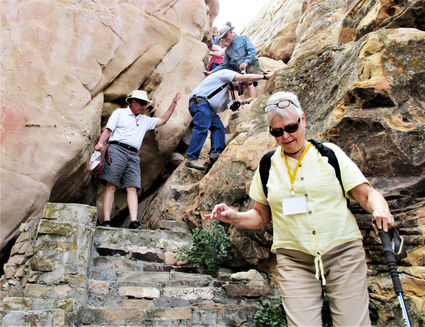
Nancy Fox, a Hi-Line Traveler from Glasgow, Montana, works her way down the "ancient staircase" with other visitors at the Acoma Pueblo. The staircase was shewn from rock sometime around 1200 A.D. on the side of the 370 foot mesa that protrudes up from the desert floor. The isolated nature of the steep sides of the mesa helped provide security for the people who lived atop the mesa. When the natural cisterns on top dried, women would use the staircase to haul water from sources on the desert floor. Farmers would use the staircase to carry farm produce and livestock from the fields below to the pueblo atop the mesa.


